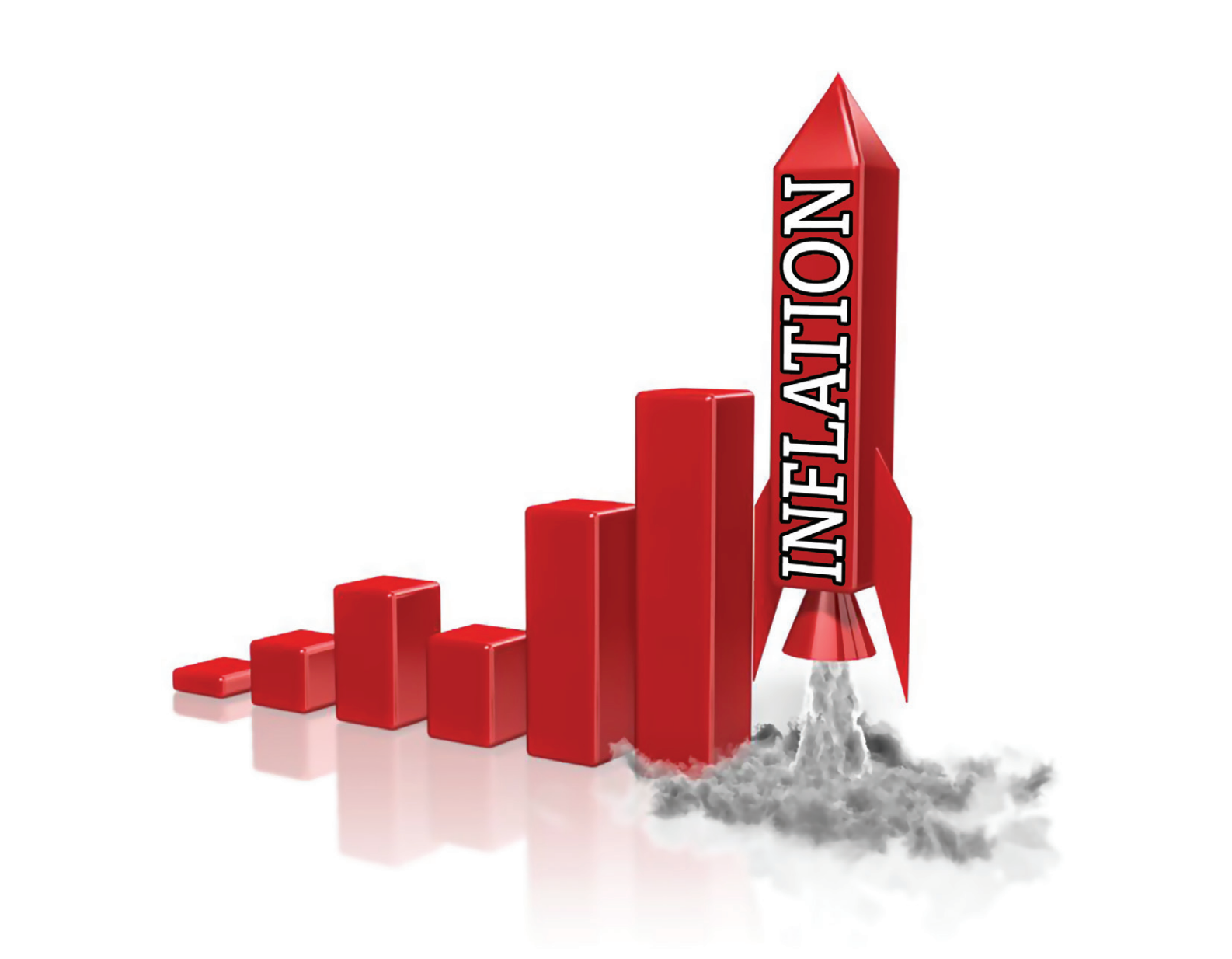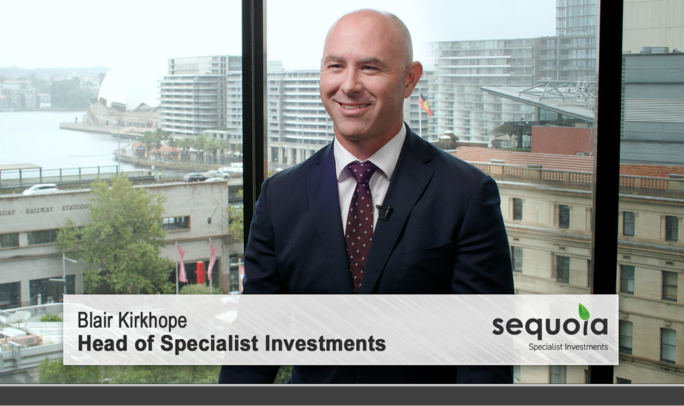The inflation conundrum and where to invest?
When reviewing the financial news lately, plenty has been said about rising inflation in recent months. This has been especially the case for the United States where the closely watched inflation gauge, the Consumer Price Index (CPI), exploded to a 40 year high in March 2022 with a reading of 8.5% from a year earlier. This reflected prices soaring on everything from petrol, food, transportation and housing.
Until March 2022, the US Federal Reserve (“the Fed”) Chairman Powell, had been suggesting during 2021 that the rising inflation was merely transitory as a result of the low base effects coming from 2020. However, this suggestion was quickly put to bed in March and the Fed had no choice but to change its course on interest rates as a result of the sudden change in inflation expectations. This is a quote from the Minutes of the Federal Open Market Committee March 15–16, 2022.
Following the Russian invasion of Ukraine and the subsequent imposition of an array of sanctions…global financial conditions tightened, reflecting declines in equity prices, increases in sovereign yields and credit spreads, and— for the United States— an appreciation of the dollar. Prices of commodities that Russia exports, particularly oil and natural gas, soared over the period. While oil prices partially retracted late in the period, options prices suggested considerable probability that oil prices could remain elevated or rise further in the months ahead. Alongside the rise in commodities prices, measures of near term inflation compensation increased sharply across advanced economies.
With inflation rising rapidly not just in the US but across many other parts of the world, various central bankers have been forced to use the only lever available to them in an attempt to bring it under control: higher interest rates.
Bonds and equities have been falling in response, as was evidenced in the sharp move lower in both the S&P 500 and 7–10 year US treasury bond prices over the last 6 months.
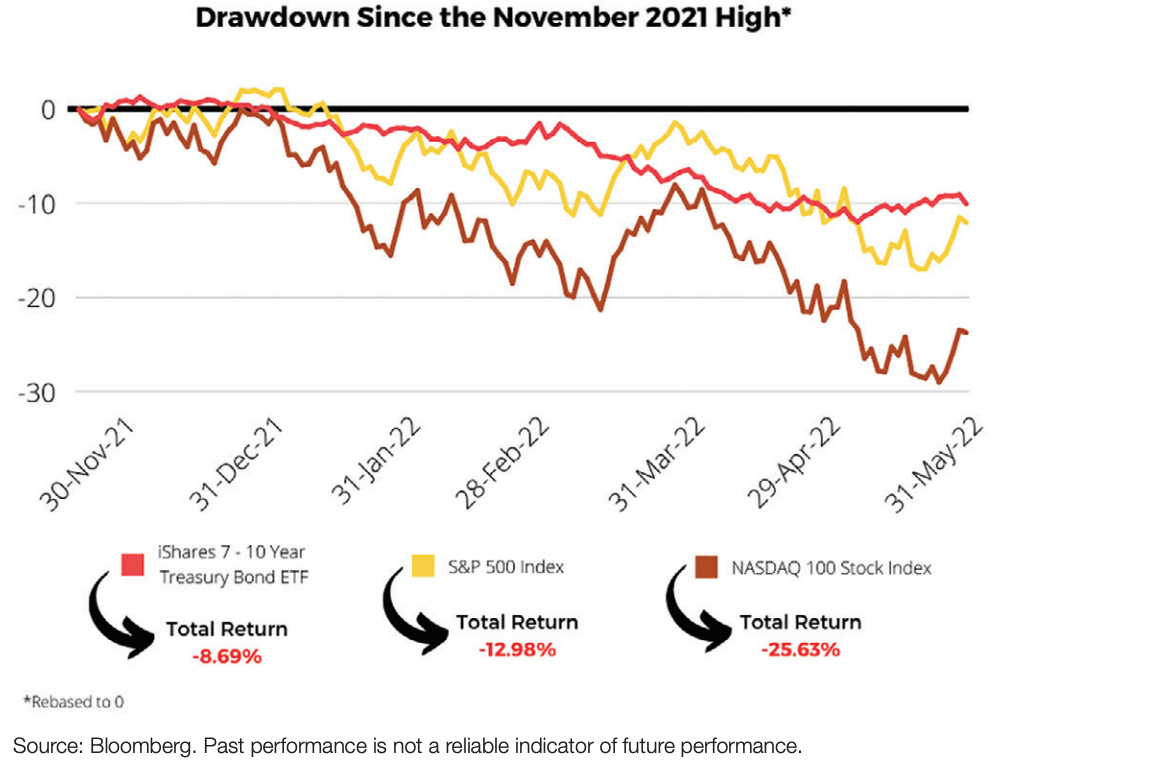
The inflation conundrum
This does present a conundrum for investors with traditionally diversified equity/bond portfolios. If bonds and equities are falling, what other investments can be considered that can be reasonably expected to add value to portfolios during periods of high inflation?
Before answering this question, lets dig a little deeper to try and understand the economic mechanism through which higher inflation leads to lower bond and equity prices.
So why does high inflation drive markets lower?
Given bond yields reflect the combination of:
- future expected interest rates;
- inflation expectations; and
- a risk premium,
a rise in both inflation and interest rates means that investors will demand higher yields from bonds. This forces bond prices lower in order to achieve a higher yield given the inverse relationship between bond prices and yields.
Impact on Tech Shares
Equities, on the other hand, fall for a variety of reasons. Technology shares with high levels of leverage and valuations based on expected future revenue streams (rather than strong current operational revenues), tend to be hit the hardest. The rise in funding costs directly impacts the bottom line. This brought into question some of the exuberant valuations of various tech shares listed on the Nasdaq leading into November 2021. Many of these valuations now appear to have been heavily reliant upon the extremely low interest rate regime. The best example of this is the ARK Innovation ETF managed by Cathie Wood, which invested in many companies focusing on future disruption.
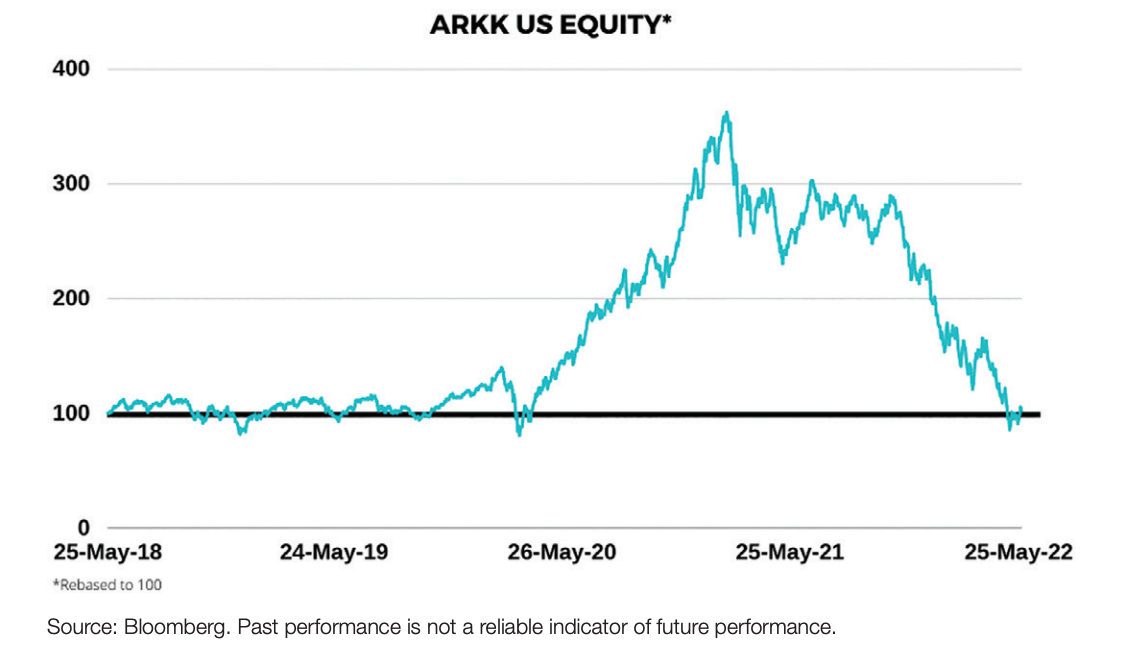
Notwithstanding the above, there does come a point when some of these tech shares might ironically start offering a value opportunity to investors who have the right stock picking skill, not to mention risk appetite.
Impact on broader equity markets
Greater economic uncertainty due to high inflation also impacts the wider equity markets as companies find it harder to plan, invest, grow and engage in long term contracts. Moreover, although companies with market power can increase prices to mitigate the impact of an unexpected surge in costs, many smaller companies are unable to pass on the full increase in costs to their customers. Margins could therefore shrink putting pressure on wages. Further, higher inflation can lead to a fall in consumer sentiment and general economic weakness. Higher living costs through higher mortgage payments, rents, petrol and grocery costs can lead to lower disposable income (unless wages increase to a similar extent) meaning less discretionary spend. If we have less construction due to greater uncertainty over project completion costs or property prices start to fall due to higher interest rates, this can lead to lower consumer sentiment and concern for the future.
Some analysts are not expecting a sudden reversal in fortunes for the wider equity and bond markets, and we believe the S&P 500 for example could continue to remain under pressure at least until US inflation starts to show signs of not just coming back under control but reversing back towards more reasonable levels of 2–3% p.a.
Notwithstanding the above, we believe it is important for investors to understand what is driving inflation higher and whether these underlying drivers can be expected to continue into the future. If so, then it makes sense for investors to consider inflation hedging solutions for their portfolios.
What is driving inflation?
We believe the major drivers of inflation over the last few years are as follows:
- Covid lockdowns crushing many supply chains and giving rise to shortages across various commodities;
- The global clean transition away from fossil fuels in response to climate change leading to oil and natural gas pipelines, oil drilling leases and coal fired power plants being cancelled and planned to close;
- The Ukraine/Russia war and subsequent sanctions imposed on Russia and the impact this is having on the supply of Natural Gas, Oil, Nickel and Wheat to mention a few; the EU agreeing to ban 90% of all Russian oil import by the end of 2022 is a good example. Will demand for oil be destroyed to the same extent to which it will be removed from the market by the end of the year, or will there be another source of supply entering the market which replaces that which is withdrawn due to the EU ban on Russian oil; and
- Increasing food protectionism as some Asian countries in particular prevent the export of various commodities reducing global supplies (e.g. India’s recent ban on wheat exports).
Will a rise in interest rates really bring inflation under control?
We further believe that unless the world suddenly sees a resolution to the conflict in Ukraine and a sudden backflip on global climate change policies, the above-mentioned inflation drivers are here to stay for the foreseeable future. This is the case especially for Agricultural commodities and energy. Increasing interest rates will also do nothing to address these issues in our opinion. Interest rates can reduce demand but they do not fix disrupted supply chain or outright shortages. If anything, interest rates could further increase input costs for companies due to higher funding costs leading to higher consumer prices.
For these reasons, we believe high US inflation should therefore continue into at least the 2023/2024 period. As such, it can still make a lot of sense to consider an allocation to possible inflation hedging solutions until this fundamental picture changes.
What other asset classes can investors consider during a high inflationary environment?
So how can investors reallocate part of their portfolios to hedge against the impact of inflation? Rather than focusing on history for an answer to this question, lets focus on asset price movements over the last 6 months. The reason we prefer the approach is because the cause of inflation today is very different to the many high inflationary episodes of the past. i.e. Inflation today is caused by supply shortages and not excessive speculative demand.
Firstly, we can say for certain that one asset class that has outperformed the rest since the highs formed in tech shares in November 2021 is commodities.
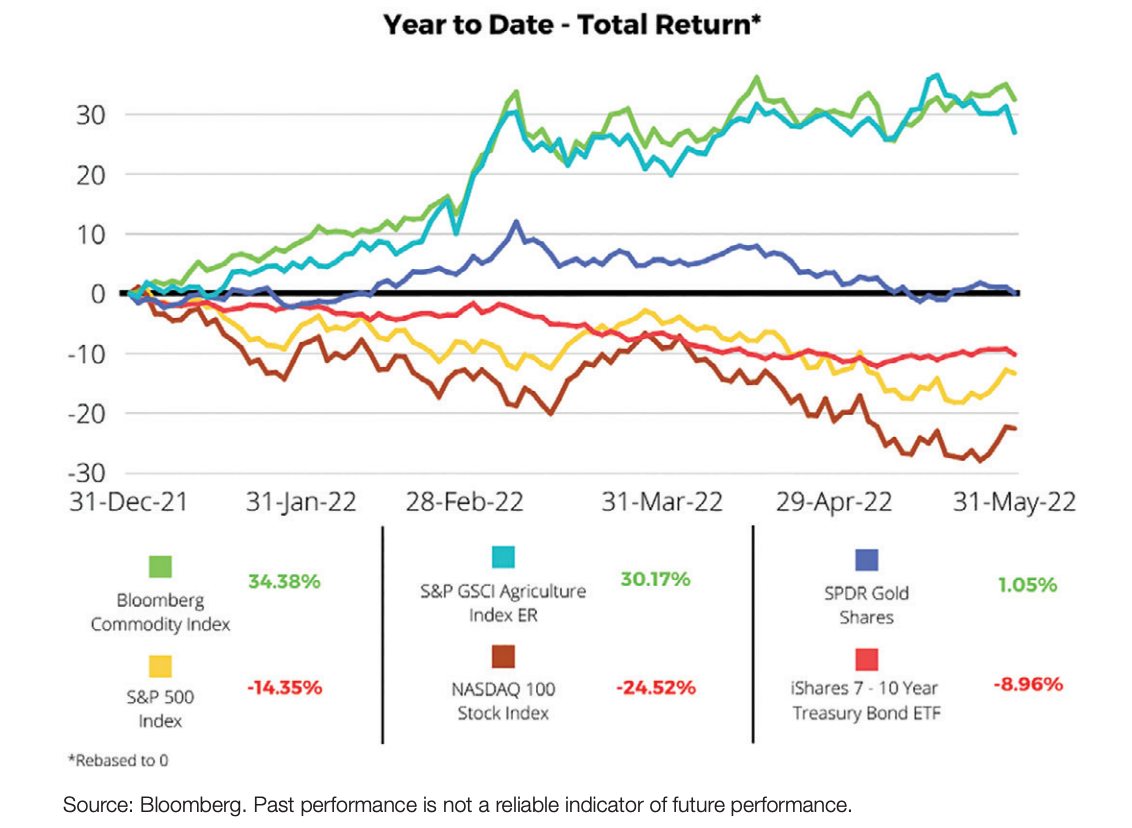
The reason for this is obvious. If commodity prices are increasing then the cost of raw materials is increasing which leads to higher consumer prices. This is most obvious with energy and the cost of petrol, electricity and some food items. The fact that the US excludes food and energy form the calculation of CPI makes no difference. These are real world inflation measures.
How to invest in commodities
This for the most part can be rather difficult. Unfortunately, in Australia there is no direct commodity investment listed on the ASX. There are direct commodity ETFs listed in the US which can be considered, however, this may force investors to crystallize losses or lower potential gains on their Equity or Bond portfolios which many investors will be reluctant to do. To this end, Sequoia Specialist Investments have been offering a variety of commodity investment solutions over the last 12 months which require only a small portfolio allocation to obtain a much larger exposure. Please refer to the link below and the summary table for their performance @ 30 April 2022.
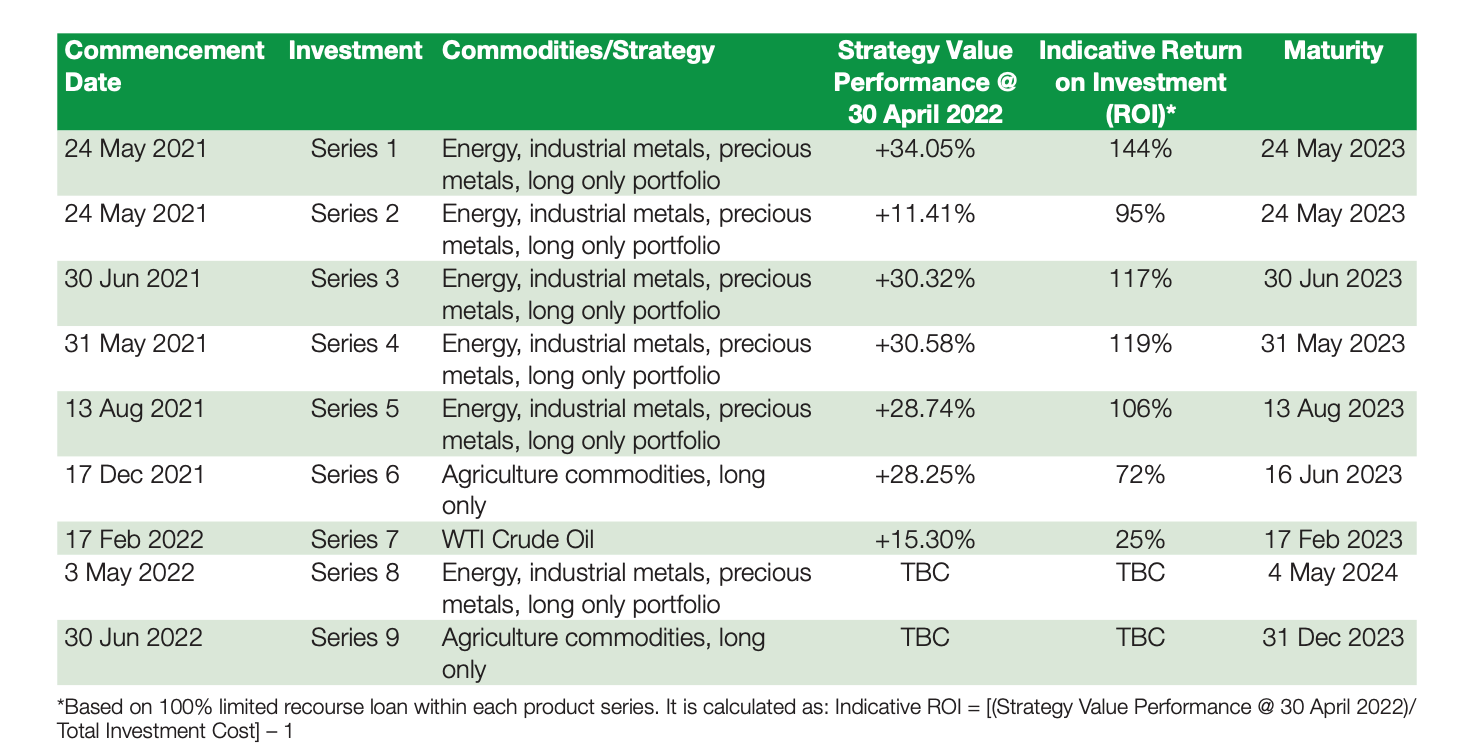
Key risks in relation to the investments listed above generally include the following:
- Risk of 100% loss or partial loss in relation to the Total Investment Cost and Upfront Adviser Fee specified in the Term Sheet PDS or Term Sheet IM;
- Significant timing risk because the Investment Term is fixed and the performance of the Strategy Value or Index (adjusted for change sin the AUD/USD exchange rate) needs to exceed the Total Investment Cost and Adviser Fee by the Maturity Date in order for investors to generate a profit;
- There is no guarantee that the Units will generate returns in excess of the Prepaid Interest and Fees, during the Investment Term; and
- Gains (and losses) may be magnified by the use of a 100% Loan. However, note that the Loan is a limited recourse Loan, so you can never lose more than your Prepaid Interest Amount and Fees paid at Commencement.
For a full description of all the risks associated with each of the above listed investments, please refer to the relevant Term Sheet PDS or IM and Master PDS or IM as per the relevant page of each investment found at: https://www.sequoiasi.com.au/commodities/

Yours sincerely,
Blair Kirkhope
Head of Specialist Investments Sequoia Specialist Investments Pty Ltd
Level 7, 7 Macquarie Place,
Sydney NSW 2000
Email: invest@sequoia.com.au
Ph:02 8114 2203
Global market reaction on Ukraine crisis, inflation & commodities
Global market reaction on Ukraine crisis, inflation & commodities
The Russian invasion into Ukraine has presented challenges for investors which has overarched the outlook of higher interest rates and hot inflation. Commodities have propelled higher in response to the perceived shortage in supply.
Blair Kirkhope, Head of Specialist Investments speaks with Melissa Darmawan from Finance News to talk about what this means for investors.
If you have any questions or would like to discuss further, please contact
Blair Kirkhope, Head of Specialist Investments
blairkirkhope@sequoia.com.au
0414 571 557 or 02 8114 2203
2022 Market Outlook and Opportunities Ahead
2022 Market Outlook
Dear Investor,
Now that we have the Ashes and the Australian Open behind us, it is a good time to have a deeper look at what’s happening with global markets. With this in mind, some of the fundamental questions we have been asking ourselves include:
- Are we facing some kind of super bubble across many asset classes including equities, real estate and commodities as some commentators have been suggesting?
- What will be the impact of rising US interest rates on the long term bullish trend seen in US equity markets?
- How long do we expect the current pullback in equity markets to last and what about the rising risk of international war between Russian/Ukraine?
- Finally, which asset classes do we expect to perform well over the next 1-2 years
A Bubble – To be or Not to Be?

Some commentators are calling the recent stock market highs in the US as the biggest bubble in history and comparing the recent market pullback in January to:
- the 1929 stock market high and subsequent crash during the Great Depression;
- Nikkei Bubble in Japan in1989 and subsequent 20 year bear market;
- the 2000 Dot.com Tech Bubble in 2000 and subsequent stock market crash in the Nasdaq.
The more traditional perspective on the market is that the extremely low interest rates and various forms of central bank stimulus around the world since the Global Financial Crisis (GFC) in 2008/2009 have created a wild speculative bubble across many asset classes over the last 13 years which are about to burst due to the prospect of rising interest rates. The suggestion is that this will then cause a major collapse in asset prices on a sustained long term basis. To be clear, we do not agree with this analysis. We do agree to some extent that rising interest rates can cause a rotation between sectors and some asset classes leading to a short term pullback. However, we also believe there are many other very important factors at play that need to be taken into account when attempting to forecast future price trends.
In particular, we subscribe to the theory that the ultimate driver of global market trends is INVESTOR CONFIDENCE. This can be influenced by confidence in a country, a government, an asset class or a stock. This is what ultimately drives international capital flows. Institutional asset allocators (e.g. pensions funds and insurance companies) are required to judge on a relative basis the many different global risk factors impacting their portfolio, in addition to interest rates and central bank stimulus, and this is what drives their primary capital allocation decisions. Protection of capital is absolutely the first priority. Once we can better understand what is driving these decisions the better we can appreciate what is driving international capital flows and the long term trends that can be expected to unfold into the future.
For example, some of the important factors taken into account can include:
- confidence in the political stability of a country;
- the confidence in a country’s economic future relative to the rest of the world;
- the stability of local and/or regional central banks (e.g. the European Central Bank);
- geopolitical risks including the risk of international war and how this impacts certain countries or regions; and
- more recently the risk of global pandemics;
- risk of government debt default.
Let us apply this way of thinking to the 3 bubble events listed above and see if we are facing a similar situation today or not.
Why this time is different
The 26 year equity market rally into the 1929 stock market high in the US was facilitated initially by the Combustion Engine and then World War I for capital concentrated in the US as a safe haven and there was a general shortage of listed equities at that time. The 2000 Dot.Com Bubble was driven by excessive expectations of Technological Innovation. The Japan 1989 Bubble was caused by the G5 announcing they wanted the US dollar down by 40% to reduce the US trade deficit which led to the 1987 Crash as capital fled the US to Japan as the USD collapsed. That then resulted in capital concentration in Japan fueling the Bubble in the Nikkei.
So it was only the 2000 Tech Bubble that was of a truly speculative nature on technology stocks exclusively. However, it must be said that also followed the Russian collapse in 1998 which resulted in the Long-Term Capital Management Crisis so capital fled Russia and then targeted the DOT.COM boom in the US.
In 2022, our view is that the current US stock market rally has been largely driven by international capital fleeing Europe and government bonds generally due to the poor economic conditions in Europe, concerns regarding the European Central Bank (ECB) and poor quality of many European government bonds. The economic situation in Europe is of major concern. The ECB’s ability to keep funding European government budget deficits via QE with extremely low (if not negative) interest rates in Europe is in question given the prospect of rising inflation. If interest rates are forced to rise in Europe this raises the risk of a major losses for the ECB which is holding the majority of European government debt. The risk of collapse in European government debt and therefore the ECB is a real concern for international institutional investors. Some commentators have indicated that US banks for example are refusing to hold European government debt as collateral due to this risk. Simply said, the US has been viewed by international investors as a much better place to invest compared to Europe simply because many investors lack confidence in how Europe, the EU and ECB is being managed. It is a lack in confidence in Europe which is helping the US from an investment point of view.
For example, the Federal Reserve is in a much better place compared to the ECB. The US Treasury market is a properly functioning market as the US government, via the Treasury, is able to easily rely on the market to buy newly issued US government debt (i.e. US Treasuries) to fund it’s budget deficits. This is unlike European governments which rely almost entirely on the ECB for this purpose since investors are not interested in investing into an asset with negative interest rates and questionable credit quality.
So, it is because of this continuing flow of international capital away from Europe into the US that we believe that we are NOT facing some kind of wild speculative bubble in US stock markets. Further, we do not see this capital flow into the US suddenly coming to an end in the short term, especially with Russia knocking on Europe’s door in Ukraine.
Therefore, as far as 2022 is concerned, the recent pullback in January certainly appears to be driven by the prospect of rising interest rates. However, is there something else going on beneath the surface from an international capital flow perspective? Are investors beginning to lose confidence in the Biden Administration as evidenced by the recent collapse in approval ratings in the his presidency? Does this have something to do with the equity market pullback as well? We are not sure but it could also be a factor. In any event, what about the impact of the Russia/Ukraine situation on Europe? Will this help to limit the extent of any decline in US stock markets if there is a sudden intensifying of capital fleeing Europe?
In our view, if Russia invades Ukraine, capital will absolutely pour into the US dollar from Europe and this is likely to be a positive for US stock markets. The same goes for China if they start something with Taiwan. So again on a relative global basis, notwithstanding all the issues facing the US domestically, there does appear on balance to be greater international risks facing other parts of the world which can lead to huge amounts of capital pouring in the direction of the US dollar and USD denominated assets. This is why we remain confident in the US equity markets over the next few years notwithstanding a risk of a further decline into March 2022.
So, yes in our opinion we can see a correction continue in US stock markets but not a major collapse and change in long term trend. On balance we expect capital to continue to flow into the US and this will intensify significantly if the risk of international war does not quickly abate.
Can we expect the same “Flight to Quality” in 2022
Notwithstanding the above, it must also be said that the only true commonality amongst all 3 historical bubble events (i.e. 1929 US, 1989 Japan, and the 2000 Tech bubble) was that each was followed by the standard flight to quality – sell equities and run into government bonds. This time, it is seriously different if international war begins in Ukraine. Yes we can see an initial sell off of equities. However, Europe has also damaged its bond market to such a large extent due to negative interest rates that the prospect of investors running back to European government bonds appears extremely unlikely. The massive spending and enormous budget deficits have also undermined the very idea that European government debt remains a quality asset. As such, if international investors are looking for a safe haven during times of international war, they will not be investing into Europe. Capital will instead pour into the USD and USD denominated assets including US equities, US treasuries and even commodities such as oil, gold and silver which are denominated in USD.
What about Commodities?
Finally, the talk that commodities are in a bubble that is somehow speculative is really counter-intuitive in our opinion. Here, the lockdowns have undermined supply chains globally and the net result is not a speculative bubble, but outright shortages. That has NOT coincided with any of the previous bubbles that people are pointing out. For example, the commodity boom peaked in 1919 ten years before the stock market in 1929. This, combined with the big push away from fossil fuels towards renewables has further accentuated the supply/demand imbalances. Finally, again if Russia invades Ukraine we can expect Energy prices to skyrocket including especially Gas and Oil, not to mention Gold &Silver.
What will be the impact of rising US interest rates on stock markets?
Lets provide a few historical examples regarding the impact of interest rates on stock markets:
During the period leading up to the 1929 stock market high, the US Federal Reserve (Fed) increased interest rates from 3.5% to 6%. During this same period the US stock market almost doubled. Capital was already fleeing Europe at this stage but further intensified into the US as interest rates were rising. It wasn’t until the Great Depression hit that the stock market crashed. Here in 2022 we have interest rates extremely low and the Fed only just now posturing to begin raising rates. So our view is that if the Fed does raise rates multiple times during 2022/2023 this will do nothing to stop international capital flows heading in the direction of the US. In fact, it could further attract international capital if the US dollar appreciates and for investors looking for higher and safer yields compared to other international assets. .
Another good example of how increasing interest rates does not necessarily mean that stock markets will crash is when Trump came to office in January 2017. At this time the Fed increased interest rates from 1% to eventually peaking at 3% in 2019, which did nothing to stop the US stock market rally peaking in 2020. It was Covid that caused the crash in 2020 and had nothing to do with interest rates.
US interest rates during Trump Administration and into 2022
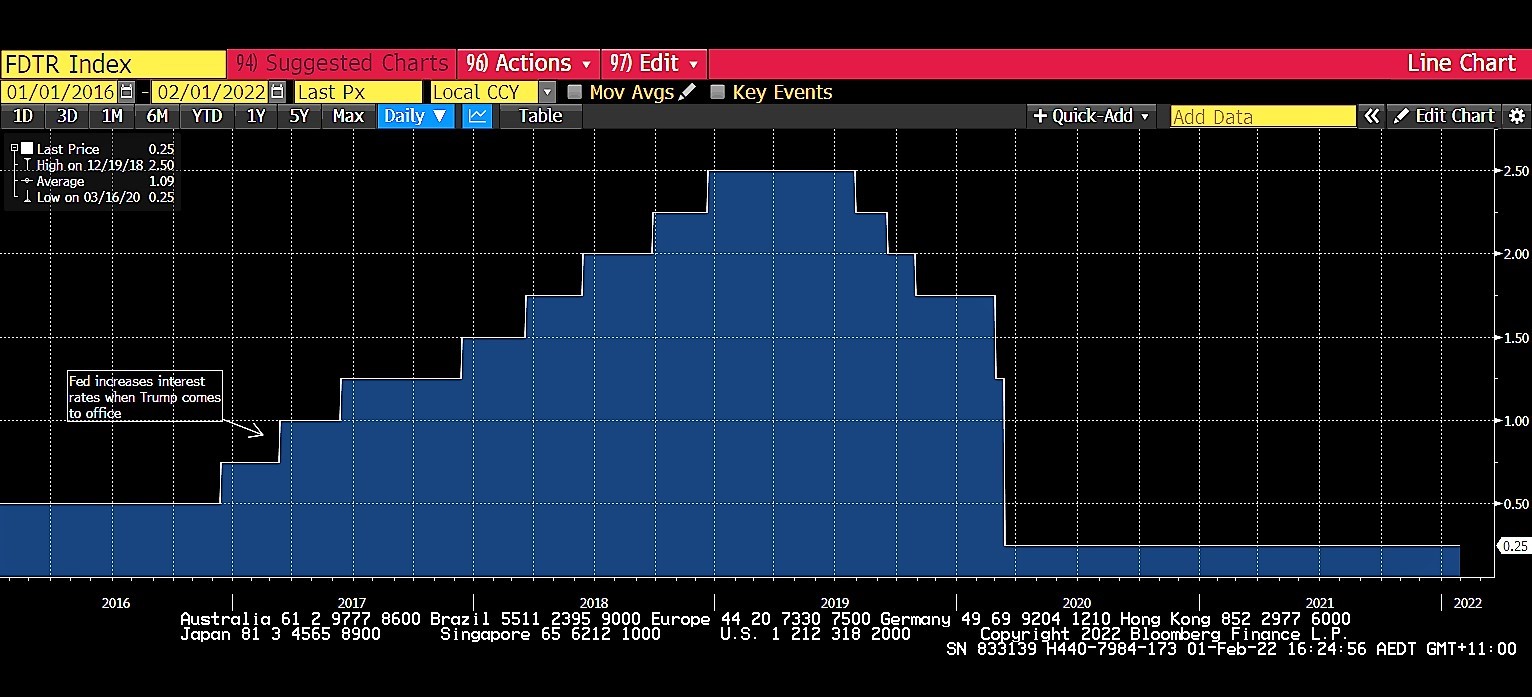
For the above reasons, we do not believe that increasing interest rates from the lowest levels in history will suddenly cause a sustained collapse in US stock markets. International capital flow driven by confidence will outweigh any possible impact of any rise in interest rates. There are simply more important issues at play which are driving capital allocation decisions by major institutions globally.
Market Outlook for US Stock Market
We agree that a near-term correction in the US stock market should continue into late February/March after an intervening bounce.
Is this a superbubble from which a complete collapse will take place? No, we think this is unlikely. Capital will not suddenly flee back to Europe under the current economic conditions in Europe with the risk of war between Ukraine and Russia. This will instead send capital pouring into the US dollar and when you add the risk of war between China and Taiwan, we expect capital will flow into the US dollar from every direction. Further, we do not see capital fleeing into many government bonds (apart from US Treasuries) either due to increased concerns regarding the credit quality of many of these assets globally due to the huge fiscal spending by many governments over the last few years and extremely low interest rates.
Therefore, our view is that capital flight to the US will continue to drive the US stock markets higher into 2023/24 once the 2022 Q1 correction is complete which we are currently expecting will occur by either late February or mid March according to important timing cycles (after an intervening bounce). Perhaps we see Russia invade Ukraine, global stocks sell-off and then that forms the low in the US and presents a buy opportunity for investors.
Upcoming investment opportunities
With this in mind we plan to offer new investment opportunities allowing investors to take advantage of a possible low in US stock markets in mid-March. As mentioned above, our current target for a possible low is February/March in line with an important turning point expected in financial markets during this time in accordance timing cycles. As such, the commencement of our next product will coincide with this timeframe with the objective of enabling an excellent entry point for our investors and an ability to catch a rebound of the US stock markets into late 2023/2024. One possible scenario is for the S&P 500 to fall back to support at 4050 level by mid March which we believe would present an excellent buy opportunity. See chart below.
We do expect various other similar opportunities in the US to present themselves over the next 1-2 months.
Watch this space as we will be opening some new investments soon..
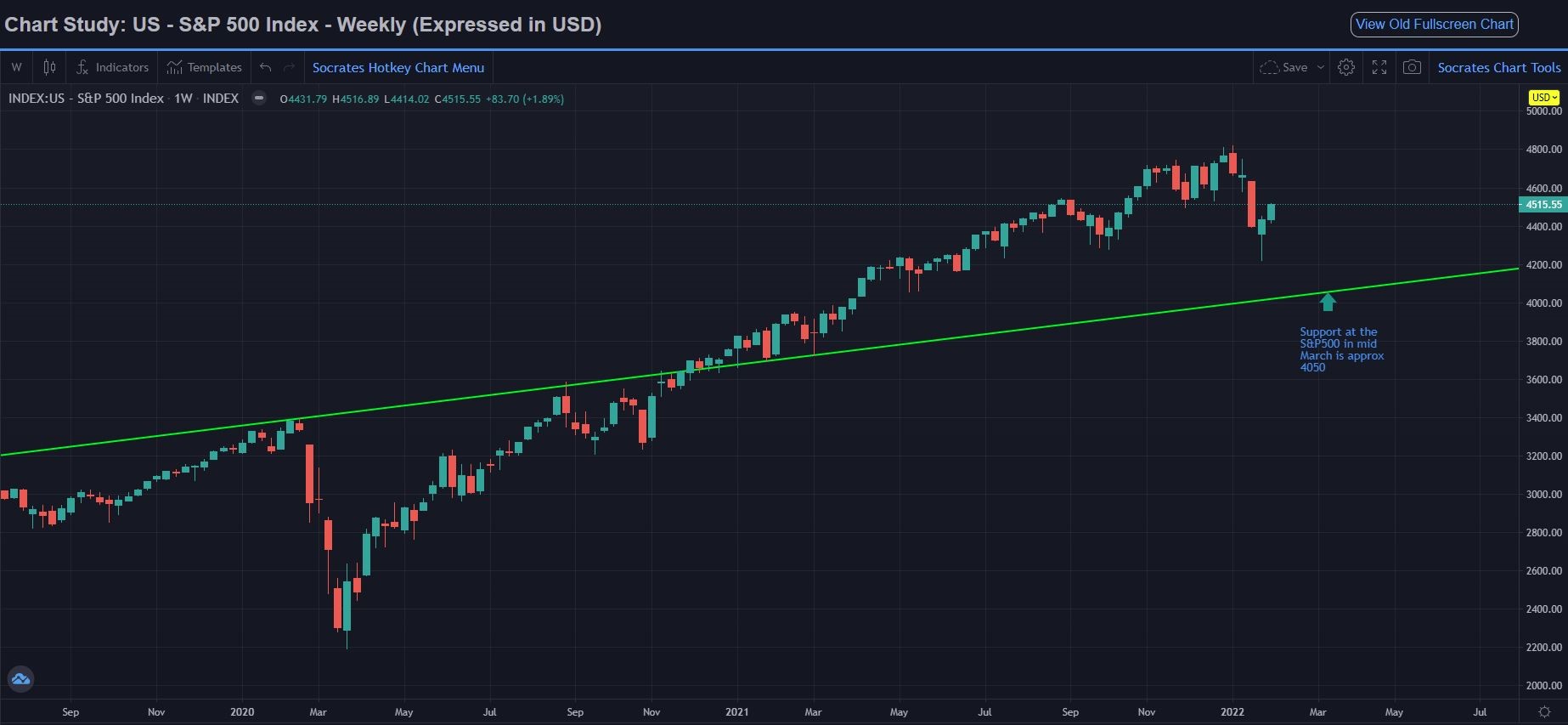
Yours faithfully,
Head of Specialist Investments

